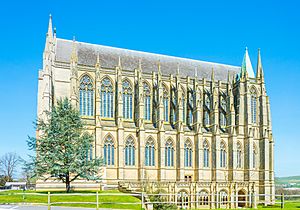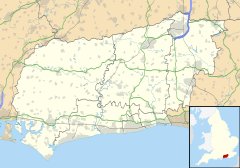Lancing, West Sussex facts for kids
Quick facts for kids Lancing |
|
|---|---|
 Lancing College Chapel |
|
| Area | 14.14 km2 (5.46 sq mi) |
| Population | 18,810 (Civil Parish 2011) |
| • Density | 1,330/km2 (3,400/sq mi) |
| OS grid reference | TQ184049 |
| • London | 47 miles (76 km) N |
| District |
|
| Shire county | |
| Region | |
| Country | England |
| Sovereign state | United Kingdom |
| Post town | LANCING |
| Postcode district | BN15 |
| Dialling code | 01903 |
| Police | Sussex |
| Fire | West Sussex |
| Ambulance | South East Coast |
| EU Parliament | South East England |
| UK Parliament |
|
| Website | Parish Council |
Lancing is a large coastal village in West Sussex, England. It is located in the Adur district, right on the edge of the Adur Valley. Lancing is nestled between the smaller village of Sompting to the west and the larger town of Shoreham-by-Sea to the east. To its north is the parish of Coombes.
Lancing is known for its homes near the coast and its beautiful farmland. You can also find wildlife areas in the northern chalk downs and near the River Adur estuary. Some buildings in Lancing are very old, dating back to the early 1500s. In 2011, about 18,810 people lived in Lancing and Coombes.
In the mid-1800s, Lancing was a popular place for seaside holidays. Today, you can still see traditional guesthouses along the A259 coast road. There's also a caravan and campsite for visitors. You can rent beach chairs and buy ice cream by the sea.
Contents
Exploring Lancing's Location
Lancing has a shingle beach. When the tide is low, you can find nice stretches of clean sand. Part of the coast road runs next to Widewater. This is a long, narrow brackish lagoon. It's a special place, and it was once home to the rare Ivell's sea anemone.
Just north of the village is Lancing Ring. This is a Nature Reserve within the South Downs National Park. Further north, you'll find farmland connected to Lancing College Farm. On the eastern side of Lancing is Shoreham Airport. This airport is the oldest one in the world that has been open continuously. It was even an RAF base during World War II.
Boundaries and Local Streams
The western edge of Lancing, next to Sompting, is marked by Boundstone Lane. This lane gets its name from a special boundary stone. This stone once showed where the village boundary was. Today, the stone is kept at Boundstone Nursery School.
The northern boundary of Lancing, with the village of Coombes, follows the Ladywell Stream. This stream flows from the South Downs, close to Lancing College. The source of this stream, the Ladywell Spring, is thought to be an ancient holy well. People believe it had special meaning even before Christianity.
Lancing's Rich History
In 1828, people found remains of an Iron Age shrine near Lancing Ring. To its west, they found a later Romano-British temple. This temple was built around the 1st century AD. It was inside an oval sacred area called a temenos.
An old track has existed since Celtic British times. This track went from Chanctonbury Ring to Cissbury Ring, then to Lancing Ring. From there, it likely led to a ford (a shallow river crossing) over the River Adur. This ford was near the modern Sussex Pad, close to the Old Tollbridge at Old Shoreham. In the low-lying farmland east of the village, you can still find remains of medieval salt workings. A Roman road also passed through North Lancing. It went from Noviomagus Reginorum (Chichester) to Novus Portus (likely Portslade near Brighton) and down to the ford.
Lancing in the 1800s and Early 1900s
Much of the land where houses now stand was once used for growing fruits and flowers. These were sold at the Brighton Market or Covent Garden in London. Large businesses like Sparks grew tomatoes, and Young's grew beautiful carnations. Frank Lisher grew chrysanthemums on his land. Nash's fruit growers even grew grapes under huge glass covers called cloches. These cloches could be moved on a rail track.
Lancing railway station opened in 1849. Between 1908 and 1912, the London, Brighton and South Coast Railway built its Lancing Carriage Works. This was a factory for making railway wagons and carriages. It was located in the area that is now the Lancing Business Park. The factory closed in 1965. Most of the land was then turned into the business park, also known as the Churchill Industrial Estate.
Not many buildings from before 1820 still exist here. One example is an old farmhouse in the village center. It is now a home called Monks Farm Presbytery on North Road.
Lancing After 1945
After World War II, growing fruits and vegetables became less common. People started importing more exotic fruits. So, the land was used for building houses instead. This growth was fastest between 1945 and 1970. Since then, housing has continued to grow, but more slowly.
Lancing has a large business park today. Companies like Equiniti are located there. This company helps manage share transfers for many big banks and companies. Lancing is also part of the larger Brighton/Worthing/Littlehampton conurbation. This means it's connected to these bigger towns for jobs and transport.
What Lancing's Name Means
The name Lancing probably means "the people of Wlanc" or "people of Hlanc." Many places in Sussex have an -ing ending. This ending means "people of." "Wlanc" seems to mean proud, while "Hlanc" means thin or lean. Some people thought Lancing was named after Wlencing, the son of the South Saxon king Ælle. However, this idea has been shown to be incorrect.
Important Landmarks in Lancing
Shoreham Tollbridge is a very old and important bridge. It's a Grade II* listed building, which means it's historically significant. It was the last toll bridge in Sussex where you had to pay to cross. The bridge was used by cars until 1970. That's when a new road, the A27 flyover, was built over the River Adur. The bridge is in the east of Lancing parish, crossing the Adur into Shoreham.
Shoreham Airport is also in Lancing parish. It opened in 1911 and is the oldest licensed airfield in the UK.
Lancing College has a beautiful chapel. It was mostly built in the 1800s. It is the largest school chapel in the world. It also has the biggest stained-glass rose window in England. This window was finished in 1977.
Education in Lancing
The main secondary school for Lancing is The Sir Robert Woodard Academy. It used to be called Boundstone Community College. This school is actually just inside the nearby village of Sompting. It's a mixed school for about 1,100 students aged 11 to 18.
In the north-east of the parish, on the Downs, is Lancing College. This is an independent school and a very well-known landmark.
Lancing also has three primary schools:
- Seaside Primary (formerly Freshbrook First School and Thornberry Middle School)
- The Globe Primary (formerly The Willows First School and Oakfield Middle School)
- North Lancing Primary School
Seaside Primary and The Globe Primary were created in 2008-2009. This happened when the middle schools joined with the nearest first schools. North Lancing Primary School has always taught both younger and older primary students.
Lancing's Literary Connections
The famous writer Oscar Wilde visited Lancing in the 1890s. He stayed in nearby Worthing. His famous play, The Importance of Being Earnest, was almost called Lady Lancing. Wilde's friend, the poet Lord Alfred Douglas, lived in nearby Brighton. He passed away while staying at Monk's Farmhouse in Lancing.
Another poet, Algernon Charles Swinburne, also visited Lancing. He stayed at The Terrace in the 1880s. The writer Ted Walker was born in Lancing in 1934. He grew up on Brighton Road, near the Widewater. His book, The High Path, is named after a footpath that ran between Brighton Road and the Widewater.
Sports in Lancing
Football
The Premier League club Brighton & Hove Albion trains in Lancing. Their training ground is at Mash Barn Lane. Some of their Under 21 matches are also played here. Nearby, you'll find Worthing F.C., a semi-professional team that plays in the National League South.
Lancing has many football teams for all ages:
- Lancing F.C. is the village's main club. It was formed in 1941. They play at the Culver Road 3G Ground and Monks Recreation Ground. They are currently in the Isthmian League South East Division.
- Lancing United FC is another large adult male football club. They play at Croshaw Recreation Ground.
- Lancing United Colts F.C. and Lancing Rangers F.C. are youth football clubs. They support football for boys and girls aged 6 to 18. They play at various pitches in Lancing and Sompting.
The Sussex County Football Association is based at Culver Road in Lancing. They share ownership of the new 3G pitch there with Lancing F.C.
Cricket
There are two cricket clubs in Lancing:
- Lancing Lads Official
- Lancing Manor Cricket Club
They play at the ground near the junction of the A27 and Manor Road.
Famous People from Lancing
- The writer Ted Walker was born and grew up in Lancing.
- As a child, the famous heavyweight boxer Sir Henry Cooper was evacuated to Lancing during the war. His identical twin brother George was with him.
- Many well-known people attended Lancing College. These include novelists Tom Sharpe and Evelyn Waugh, lyricist Tim Rice, singer Peter Pears, and comedian Adam Buxton.
Twin Towns
Lancing is twinned with two towns, along with other urban areas in Adur:


